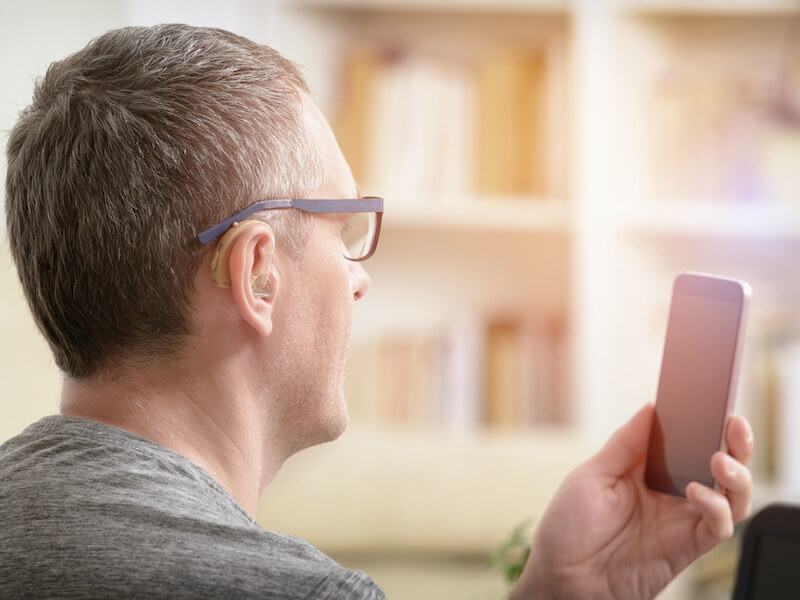
You’ve likely noted that when movies or TV shows get really intense, they begin using close-ups (maybe even extreme close-ups). This is because more information than you’re likely even consciously aware of is conveyed by the human face. To say that human beings are really facially centered is, well, not a stretch.
So it’s not surprising that the face is where all of our principal sensors are, eyes, ears, mouth, and nose. The face is cram packed (in an aesthetically excellent way, of course).
But when your face needs more than one assistive device, it can become an issue. For example, wearing glasses and hearing aids can become a little… cumbersome. It can be rather challenging in some situations. These tips on how to use hearing aids and glasses simultaneously can help you manage those challenges, and get you ready for your (metaphorical) closeup!
Are glasses impeded by hearing aids?
As both your ears and your eyes will often require a bit of assistance, it’s common for people to be worried that their eyeglasses and hearing aids may hinder each other. That’s because there are physical constraints on both the shape of eyeglasses and the positioning of hearing aids. For many individuals, wearing them at the same time can lead to discomfort.
There are a couple of key challenges:
- Pressure: Both eyeglasses and hearing aids need to affix to your face somehow; the ear is the mutual anchor. But when your ears have to hang on to both eyeglasses and hearing aids, a feeling of pressure and sometimes even pain can be the outcome. Your temples can also feel pressure and pain.
- Skin irritation: All of those bits hanging off your face can also sometimes cause skin irritation. If neither your glasses nor your hearing aids are fitting properly, this is especially true.
- Poor audio quality: It’s not unusual for your glasses to knock your hearing aids out of position, resulting in less than perfect audio quality.
So, can you wear glasses with hearing aids? Of course you can! It might seem like they’re contradictory, but behind-the-ear hearing aids can successfully be worn with glasses!
Wearing hearing aids and glasses together
It may take a little work, but whatever your style of hearing aid, it can work with your glasses. Generally, only the behind-the-ear style of hearing aid is relevant to this discussion. Inside-the-canal hearing aids are very small and fit almost entirely inside the ear so they aren’t really relevant here. There’s normally absolutely no conflict between inside-the-canal hearing aids and glasses.
Behind-the-ear hearing aids, though, sit behind your ear. The electronics that go behind your ears connect to a wire that goes to a speaker that’s situated inside the ear canal. You should speak with us about what kind of hearing aid is best for your needs (they each have their own advantages and drawbacks).
An inside-the-canal hearing aid won’t work best for everyone but if you use your glasses all day, they’re something you may want to consider. Some people will require a BTE style device in order to hear adequately, but even if that’s the situation they will be able to make it work with glasses.
Your glasses may need some adjustment
The level of comfort you get from your hearing aid will considerably depend on the style and type of glasses you have. You will want to invest in glasses that have slimmer frames if you wear a large BTE hearing aid. Work with your optician to select a glasses style that will accommodate your hearing aids.
Your glasses will also need to fit properly. You want them tight (but not too tight) and you want to make certain they aren’t too slack. The caliber of your hearing experience can be compromised if your glasses are continually wiggling around.
Using accessories is fine
So how can you use glasses and hearing aids at the same time? There are lots of other individuals who are dealing with difficulties handling hearing aids with glasses, so you’re not alone. This is good news because it means that there are devices you can use to make things a little bit easier. Here are a few of those devices:
- Retention bands: You put these bands on your glasses to help keep them in place. If you’re a more active individual, these are a good idea.
- Specially designed devices: Using your hearing aids and glasses simultaneously will be much easier if you make use of the wide range of devices available designed to do just that. Devices include pieces of cloth that hold your hearing aids in position and glasses with hearing aids built right in.
- Anti-slip hooks: If your glasses are moving all over, they can knock your hearing aid out of position and these devices help counter that. They work like a retention band but are more subtle.
These devices are made to keep you more comfortable by holding your glasses in position and securing your hearing aids.
Can glasses trigger hearing aid feedback?
Some people who wear glasses with their hearing aids do report more feedback. It’s not a very common complaint but it does occur. In some instances, the feedback you experience may be triggered by something else (such as a tv speaker or mobile phone speaker).
Still, you should definitely contact us if you think your glasses might be causing your hearing aids to feedback.
How to wear your hearing aids and glasses
Many of the difficulties linked to using hearing aids and glasses together can be prevented by making sure that all of your devices are being properly worn. You want them to fit right!
You can do that by using these tips:
First put on your glasses. After all, your glasses are pretty rigid and they’re bigger, this means they have less wiggle room with regards to adjustments.
Once you have your glasses in place, position the shell of your hearing aid between your glasses earpiece and your outer ear. Your glasses should be closest to your head.
Adjust both as necessary in order to be comfortable, then place the hearing aid microphone in your ear canal.
And that’s it! Kind of, there’s certainly a learning curve in terms of putting on and taking off your glasses without knocking your hearing aid out of place.
Keep up with both your glasses and your hearing aids
If either of your devices (glasses and hearing aids) isn’t well maintained, the conflict between the two can be increased. Sometimes, things break! But with a little maintenance, those breakages can be prevented.
For your hearing aids:
- Keep your hearing aids in a cool, dry place when you’re not wearing them.
- If you have a rechargeable hearing aid, keep the battery charged.
- The correct tools (a soft pick and a brush) should be used to eliminate earwax and debris.
- Be sure to clean your hearing aids at least once a week.
For your glasses:
- Bring your glasses to your optician if they stop fitting properly.
- Utilize a microfiber cloth to clean your glasses. Your lenses could easily become scratched by a paper towel or your shirt, so don’t use them.
- Keep your glasses in a case when you’re not using them. Or, you can keep them in a safe dry place if you don’t have a case.
- When your glasses get dirty, clean them. Typically, this is at least once a day!
Sometimes you need professional assistance
Hearing aids and glasses are both specialized devices (even though they may not seem like it on the surface). This means that it’s crucial to speak with professionals who can help you find the best fit possible for both your hearing aids and your glasses.
Preventing issues rather than trying to fix them later can be accomplished by getting the right help in the beginning.
Your glasses and hearing aids can get along with one another
If you haven’t already realized it, now it’s time to accept that hearing aids and glasses don’t need to fight with each other. Sure, it can, at times, be a challenge if you require both of these devices. You will be able to be more focused on enjoying your life and less on keeping your hearing aid in place with our help.

